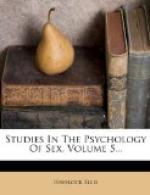When the idea of erotic symbolism as manifested in such definite and typical forms becomes realized, it further becomes clear that the vaguer manifestations of such symbolism are exceedingly widespread. When in a previous volume we were discussing and drawing together the various threads which unite “Love and Pain,” it will now be understood that we were standing throughout on the threshold of erotic symbolism. Pain itself, in the sense in which we slowly learned to define it in this relationship—as a state of intense emotional excitement—may, under a great variety of special circumstances, become an erotic symbol and afford the same relief as the emotions normally accompanying the sexual act. Active algolagnia or sadism is thus a form of erotic symbolism; passive algolagnia or masochism is (in a man) an inverted form of erotic symbolism. Active flagellation or passive flagellation are, in exactly the same way, manifestations of erotic symbolism, the imaginative mimicry of coitus.
Binet and also Krafft-Ebing[64] have argued in effect that the whole of sexual selection is a matter of fetichism, that is to say, of erotic symbolism of object. “Normal love,” Binet states, “appears as the result of a complicated fetichism.” Tarde also seems to have regarded love as normally a kind of fetichism. “We are a long time before we fall in love with a woman,” he remarks; “we must wait to see the detail which strikes and delights us, and causes us to overlook what displeases us. Only in normal love the details are many and always changing. Constancy in love is rarely anything else but a voyage around the beloved person, a voyage of exploration and ever new discoveries. The most faithful lover does not love the same woman in the same way for two days in succession."[65]
From that point of view normal sexual love is the sway of a fetich—more or less arbitrary, more or less (as Binet terms it) polytheistic—and it can have little objective basis. But, as we saw when considering “Sexual Selection in Man” in the previous volume, more especially when analyzing the notion of beauty, we are justified in believing that beauty has to a large extent an objective basis, and that love by no means depends simply on the capricious selection of some individual fetich. The individual factor, as we saw, is but one of many factors which constitute beauty. In the study of sexual selection that individual factor was passed over very lightly. We now see that it is often a factor of great importance, for in it are rooted all these outgrowths—normal in their germs, highly abnormal in their more extreme developments—which make up erotic symbolism.




